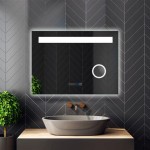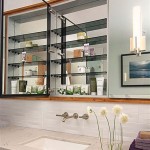How To Hang A Mirror On A Pocket Door Wall
Hanging a mirror can significantly enhance the aesthetic appeal and functionality of any room. Mirrors can create an illusion of spaciousness, reflect light to brighten darker areas, and serve as decorative focal points. However, the task becomes complicated when the desired location is a wall containing a pocket door. Pocket doors, which slide into a recess within the wall, present unique challenges due to the limited structural support and the potential for interference with the door's operation. Successfully hanging a mirror on a pocket door wall requires careful planning, specialized techniques, and an understanding of the wall's construction.
The primary concern when hanging anything on a pocket door wall is the risk of damaging the door or its track. Pocket doors are typically supported by a track system located at the top of the door opening. The wall cavity houses the door when it is open, which means that standard wall studs are often absent or significantly reduced in size and number compared to a standard wall. Directly nailing or screwing into the wall without knowing its internal structure can lead to several undesirable outcomes, including puncturing the door itself, dislodging the track, or compromising the structural integrity of the wall. Therefore, undertaking this project demands a methodical approach to ensure both the mirror is securely mounted and the pocket door continues to function properly.
Before beginning any installation, it is crucial to assess the wall's construction. This assessment involves determining the presence and location of any studs, identifying the path of the pocket door when it is in the open position, and taking precise measurements. The weight of the mirror is also a critical factor. Heavier mirrors require more robust mounting solutions to prevent them from falling and causing damage. By carefully considering these elements, it is possible to hang a mirror on a pocket door wall safely and effectively.
Identifying the Wall Structure
The first and perhaps most important step is to identify the internal structure of the pocket door wall. Unlike conventional walls with studs spaced at regular intervals, pocket door walls often have a modified framing system to accommodate the door's sliding mechanism. Standard stud finders may not be reliable in this situation, as they are designed to detect consistently spaced studs. Instead, utilize a combination of techniques to map the wall's internal components:
Knocking and Listening: Gently tap along the wall surface. A solid sound generally indicates the presence of a stud or framing member behind the drywall. In contrast, a hollow sound suggests an empty cavity. Mark the locations where the sound changes, as these transitions can indicate the edges of structural elements.
Using a Strong Magnet: Metal studs are sometimes used in pocket door walls, particularly in newer construction. A strong magnet can help locate these studs by detecting the metal screws or nails used to attach the drywall to the studs. Move the magnet slowly across the wall surface, and note any areas where it is attracted. This method can be particularly effective in identifying the vertical framing members along the pocket door opening.
Drilling Pilot Holes (With Extreme Caution): If the previous methods are inconclusive, consider drilling small pilot holes. Choose a drill bit that is significantly smaller than any screws you plan to use for mounting the mirror. Drill carefully and shallowly, only penetrating the drywall. If you encounter resistance, you have likely hit a stud or framing member. If the drill passes through easily, you are in an empty cavity. Mark the location of each pilot hole, and avoid drilling excessively to minimize damage to the wall.
Examining Existing Fixtures: If there are any existing outlets, light switches, or other fixtures on the same wall, carefully examine how they are mounted. Removing the cover plates may provide insights into the wall's construction and the presence of any support structures. However, be sure to turn off the power to the circuit before removing any electrical fixtures, and exercise extreme caution to avoid electrical shock.
Once you have gathered information using these techniques, create a detailed diagram of the wall's internal structure. This diagram will serve as a guide for determining the safest and most secure locations for mounting the mirror.
Choosing the Right Mounting Hardware
Selecting the appropriate mounting hardware is critical for ensuring the mirror is securely attached to the pocket door wall without damaging the door or its mechanism. The weight of the mirror, the type of wall construction, and the available support structures will influence the choice of hardware. Several options are available, each with its own advantages and disadvantages:
Lightweight Mirrors (Under 5 lbs): For smaller, lighter mirrors, adhesive mounting strips or hooks may be sufficient. These products are designed to adhere to smooth surfaces like drywall and can support a limited amount of weight. However, it is essential to choose high-quality adhesive strips specifically rated for the weight of your mirror and to follow the manufacturer's instructions carefully. Clean the wall surface thoroughly before applying the adhesive to ensure a strong bond. While convenient, adhesive mounting is not recommended for larger or heavier mirrors due to the risk of failure.
Anchors: When attaching to drywall alone (i.e., not hitting a stud), wall anchors are essential. Several types of anchors are available, each designed for different weight capacities and wall thicknesses.
Drywall Anchors: Expandable plastic or metal anchors are commonly used for lighter loads. These anchors expand behind the drywall as a screw is inserted, providing a secure hold. Choose anchors rated for at least the weight of your mirror, and follow the manufacturer's instructions for installation. Over-tightening can damage the drywall and weaken the anchor's hold.
Toggle Bolts: Toggle bolts are a more robust option for heavier mirrors. They consist of a bolt and a spring-loaded wing that expands behind the drywall, distributing the weight over a larger area. Toggle bolts offer significantly greater holding power than drywall anchors, making them suitable for heavier mirrors. Installing toggle bolts requires drilling a larger hole in the drywall, so it is important to measure carefully and avoid drilling excessively.
Heavy Duty Mirror Mounting Kits: These kits are specifically designed for hanging mirrors and typically include specialized hardware such as Z-hangers or French cleats. These systems distribute the weight of the mirror evenly and provide a secure, level mounting. Heavy-duty kits are often recommended for large or particularly heavy mirrors to minimize the risk of them falling.
Mounting to Studs (If Available): If you are fortunate enough to locate studs within the pocket door wall, attaching the mirror directly to the studs is the most secure option. Use screws that are long enough to penetrate the stud deeply, providing a strong and stable hold. Pre-drilling pilot holes is essential to prevent the wood from splitting.
No matter what hardware you select, ensure it's rated to hold at least the weight of the mirror, with a safety margin. Double-check the weight rating of the hardware.
Installation Techniques and Precautions
After identifying the wall structure and selecting the appropriate mounting hardware, the final step is to install the mirror. Accuracy and caution are paramount to avoid damaging the wall, the pocket door, or the mirror itself. Follow these guidelines for a successful installation:
Precise Measurements: Accurate measurements are crucial for ensuring the mirror is hung in the desired location and is level. Use a level and a measuring tape to mark the placement of the mounting hardware on the wall. Double-check your measurements to avoid errors.
Pilot Holes: Pre-drilling pilot holes is essential, especially when using screws or anchors. Pilot holes prevent the wood from splitting and make it easier to insert the screws or anchors straight and true. Use a drill bit that is slightly smaller than the diameter of the screw or anchor.
Avoiding the Door Path: Exercise extreme caution to avoid drilling or screwing into the path of the pocket door. Use the diagram you created to identify the door's location when it is in the open position. Ensure that all mounting hardware is positioned well clear of the door's path to prevent any interference with its operation.
Distributing Weight: For heavier mirrors, it is important to distribute the weight evenly across multiple mounting points. Use multiple anchors or screws to support the mirror, rather than relying on a single point of attachment. This will reduce the strain on the wall and the mounting hardware, minimizing the risk of failure.
Leveling: Once the mirror is hung, use a level to ensure it is perfectly straight. Adjust the mounting hardware as needed to achieve a level position. A crooked mirror can be visually unappealing and can even create a sense of unease.
Testing: After installation, test the stability of the mirror by gently pushing on it. Ensure that it is securely attached to the wall and does not wobble or move. If you detect any movement, re-tighten the mounting hardware or add additional support if necessary.
Protecting the Mirror: During installation, protect the surface of the mirror from scratches or damage by covering it with a soft cloth or cardboard. Handle the mirror carefully to avoid breaking it.
Professional Assistance: If you are unsure about any aspect of the installation process, or if you are dealing with a particularly heavy or valuable mirror, consider hiring a professional installer. A professional will have the experience and expertise to install the mirror safely and securely, minimizing the risk of damage to the wall, the door, or the mirror itself.
Alternative Placement Considerations
When hanging a mirror on a pocket door wall proves too risky or structurally unsound, alternative placement locations should be considered. These options may provide a safer and more secure mounting surface while still achieving the desired aesthetic effect.
Adjacent Walls: Evaluate the walls adjacent to the pocket door wall. These walls may offer more stable support and easier access to studs. Consider how the mirror will reflect light and space from this new location.
Opposite Walls: Placing the mirror on the wall opposite the pocket door can still achieve the goal of expanding the perceived space of the room. This option is particularly effective if the opposite wall is a blank canvas with no structural limitations.
Freestanding Mirrors: Large, freestanding mirrors can be a stylish alternative to wall-mounted options. These mirrors come in various shapes and sizes and can be easily moved and repositioned as needed. They eliminate the need for drilling or mounting, reducing the risk of damage to the pocket door wall.
Floor Mirrors: Leaning floor mirrors against the wall can also create a similar effect to wall-mounted mirrors without requiring any installation. These mirrors add a touch of elegance and can be easily adjusted to suit your preferences.
By considering these alternative placement options, you can achieve the desired aesthetic outcome without compromising the structural integrity of the pocket door wall.

Mirrored Pocket Door Jack And Jill Bathroom Update Sawdust Girl

Mirrored Pocket Door Jack And Jill Bathroom Update Sawdust Girl

Bathroom Idea Add A Full Length Mirror Into Madison Hollow Pocket Door From Home Depot Genius Small Remodel Bathrooms Decor

How To Diy A Bathroom Pocket Door With Mirror One Side Hundred Acres Home

Pocket Door With 2 Sided Mirror Leads To Walk In Closet Bathroom Storage Trendy Doors

Saving Space And Gaining Style With Over The Door Mirrors

Mirrored Pocket Door Jack And Jill Bathroom Update Sawdust Girl

Hainging Artwork On Wall Next To Pocket Door

Saving Space And Gaining Style With Over The Door Mirrors

Built Up Pocket Door Frames Marwin Company








